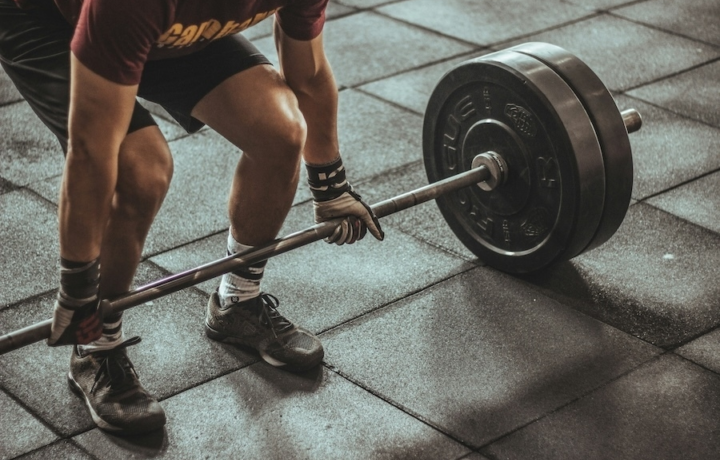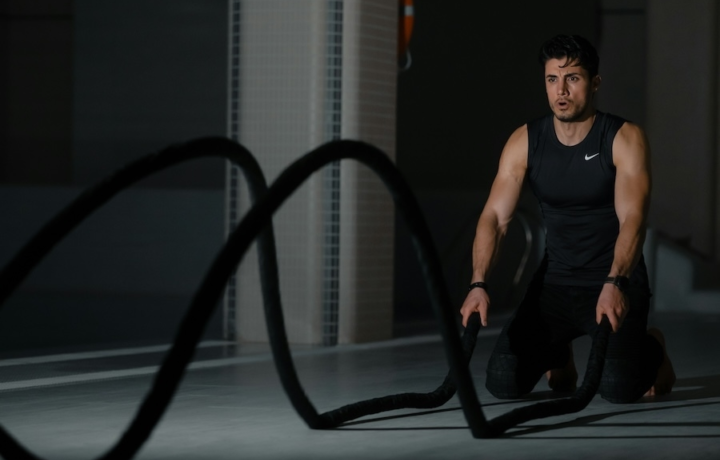Exercise
Kettlebell Swing

Kettlebell Swing
How to Perform
- Stand with feet shoulder-width apart, toes slightly pointed outward, and place a kettlebell on the floor between your feet.
- Hinge at your hips while maintaining a neutral spine, bend your knees slightly, and grasp the kettlebell handle with both hands using an overhand grip.
- Pull your shoulders back and down, engage your core, and lift the kettlebell off the ground, allowing it to hang between your legs as you maintain the hip hinge position.
- Initiate the swing by explosively driving your hips forward while keeping your back flat, exhaling forcefully as the kettlebell swings forward and upward to chest height.
- Keep your arms straight but not locked, allowing them to float naturally as the power comes from your hip drive, not your shoulders or arms.
- As the kettlebell reaches its apex, inhale and allow it to descend back between your legs, hinging at your hips and loading your hamstrings.
- Control the descent by engaging your lats and core, allowing the kettlebell to pass between your legs as you prepare for the next repetition.
- Immediately transition into the next swing by driving your hips forward powerfully, maintaining tension in your core and glutes throughout the movement.
Important information
- Keep your back flat throughout the entire movement—never round your lower back, even at the bottom position.
- Focus on the hip hinge rather than squatting; your knees should bend only slightly while your hips move backward significantly.
- The power should come from your hip drive, not your arms or shoulders, which simply guide the kettlebell's path.
- Start with a lighter kettlebell to master proper form before progressing to heavier weights.

Kettlebell Swing
Exercise Details
Primary Muscles
Muscle Groups
Mechanic
Risk Areas
Built for progress
Take the guesswork out of training
Create personalized AI-powered workout plans that evolve with you. Train smarter, track every rep and keep moving forward, one workout at a time.






The kettlebell swing stands as a cornerstone in functional fitness, beloved by intermediate athletes looking to simultaneously challenge multiple muscle groups while boosting cardiovascular capacity. This dynamic movement primarily targets the posterior chain, with your glutes and hamstrings handling the heavy lifting, while your abs engage throughout to maintain stability and power generation through the hips.
What makes the kettlebell swing particularly valuable is its versatility across training methodologies. In HIIT workouts, it serves as an explosive interval option that rapidly elevates heart rate and calorie burn. Crossfit enthusiasts appreciate how it builds the power and conditioning necessary for complex movements, while bodybuilders increasingly incorporate swings as a metabolic finisher that sculpts the hamstrings and glutes without adding unwanted bulk.
The beauty of this movement lies in its triple-threat development of strength, endurance, and cardiovascular fitness. From a strength perspective, the posterior chain development translates to improved deadlifts, squats, and athletic performance. Endurance benefits emerge when performing moderate-weight, higher-rep sets that challenge muscular stamina, particularly in the grip, core, and hip extensors. Meanwhile, the ballistic nature of properly executed swings creates a cardiovascular training effect comparable to sprinting but with lower joint impact.
Many fitness enthusiasts appreciate the kettlebell swing's efficiency—few exercises deliver such comprehensive benefits in such a time-efficient package. The movement pattern also reinforces proper hip hinging, a fundamental human movement pattern often lost in our sedentary culture. This hip-dominant exercise counterbalances the quad-dominant patterns prevalent in modern workouts and daily life, potentially reducing injury risk and improving athletic longevity.
For those seeking an exercise that bridges the gap between strength training and conditioning while emphasizing posterior development, the kettlebell swing provides an evidence-based solution that continues to stand the test of time in effective fitness programming.
FAQ - Kettlebell Swing
The kettlebell swing primarily activates your posterior chain, with emphasis on glutes and hamstrings, while engaging your core, lats, shoulders, and grip as stabilizers. The power generation comes from your hips, not your arms or lower back.
Stand with feet shoulder-width apart, hinge at the hips with soft knees, and grip the kettlebell with both hands. Drive through your heels, forcefully extend your hips to propel the kettlebell to chest height (not by lifting with your arms), then let it swing back between your legs as you hinge forward.
The Russian swing ends with the kettlebell at chest or shoulder height and emphasizes hip power with less shoulder involvement. The American swing continues the arc overhead, requiring more shoulder mobility and core control, but offers less power development and potentially higher risk for those with shoulder issues.
Begin with mastering form using a lighter kettlebell (16-24kg for men, 8-16kg for women), then increase weight once you maintain perfect form for 20+ reps. You can also progress by increasing volume, decreasing rest periods, or incorporating swing varieties like single-arm, hand-to-hand, or heavy two-handed swings.
Avoid squatting instead of hinging at the hips, lifting with your arms rather than explosively driving through your hips, and rounding your lower back. Also prevent the kettlebell from swinging too far away from your body, which reduces power and increases strain on your shoulders and lower back.











